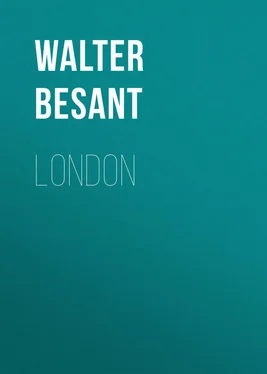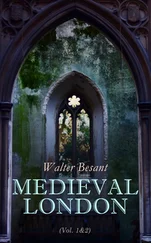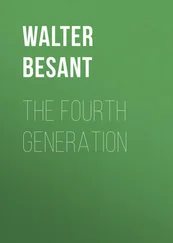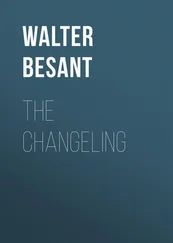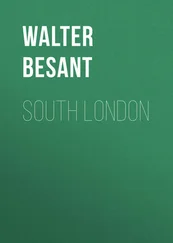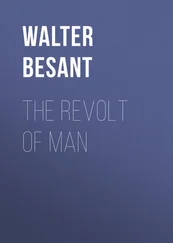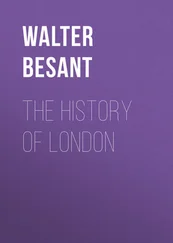Walter Besant - London
Здесь есть возможность читать онлайн «Walter Besant - London» — ознакомительный отрывок электронной книги совершенно бесплатно, а после прочтения отрывка купить полную версию. В некоторых случаях можно слушать аудио, скачать через торрент в формате fb2 и присутствует краткое содержание. Жанр: foreign_antique, foreign_prose, на английском языке. Описание произведения, (предисловие) а так же отзывы посетителей доступны на портале библиотеки ЛибКат.
- Название:London
- Автор:
- Жанр:
- Год:неизвестен
- ISBN:нет данных
- Рейтинг книги:4 / 5. Голосов: 1
-
Избранное:Добавить в избранное
- Отзывы:
-
Ваша оценка:
- 80
- 1
- 2
- 3
- 4
- 5
London: краткое содержание, описание и аннотация
Предлагаем к чтению аннотацию, описание, краткое содержание или предисловие (зависит от того, что написал сам автор книги «London»). Если вы не нашли необходимую информацию о книге — напишите в комментариях, мы постараемся отыскать её.
London — читать онлайн ознакомительный отрывок
Ниже представлен текст книги, разбитый по страницам. Система сохранения места последней прочитанной страницы, позволяет с удобством читать онлайн бесплатно книгу «London», без необходимости каждый раз заново искать на чём Вы остановились. Поставьте закладку, и сможете в любой момент перейти на страницу, на которой закончили чтение.
Интервал:
Закладка:
There was an Office of Pilgrims, which was to be rendered in the following fashion:
Two of the second stall, who may be put in the table at the pleasure of the writer, shall be clothed in a Tunic, with copes above, carrying staves across, and scrips in the manner of Pilgrims; and they shall have cappelli 3 3 A hat or bonnet. Du Cange.
over their heads, and be bearded. Let them go from the Vestiary, singing a hymn, "Jesus, our redemption," advancing with a slow step, through the right aisle of the Church, as far as the Western gates, and there stopping, sing a hymn as far as that place, "You shall be satisfied with my likeness." Then a certain Priest of the higher stall, written in the table, clothed in an Alb and Amess, barefooted, carrying a cross upon his right shoulder, with a look cast downward, coming to them through the right aisle of the Church, shall suddenly stand between them, and say, "What are these discourses?" The Pilgrims, as it were, admiring and looking upon him, shall say, "Are you a stranger?" etc. The Priest shall answer, "In what city?" The Pilgrims shall answer, "Of Jesus of Nazareth." The Priest, looking upon both of them, shall say, "O fools, and slow of heart," which being said, the Priest immediately shall retire, and pretend to be going farther; but the Pilgrims hurrying up, and following him, shall detain him, as it were, inviting him to their inn, and drawing him with their staves, shall show him a castle and say, "Stay with us." And so singing they shall lead him as far as a tent in the middle of the nave of the Church, made in the resemblance of the Castle Emmaus. When they have ascended thither, and sat at a table ready prepared, the Lord sitting between them shall break the bread; and being discovered by this means, shall suddenly retire, and vanish from their sight. But they, amazed as it were, rising, with their countenances turned to each other, shall sing lamentably "Alleluia," with the verse, "Did not our heart burn," etc., which being renewed, turning themselves towards the stall, they shall sing this verse, "Tell us, Mary." Then a certain person of the higher stall, clothed in a Dalmatick and Amess, and bound round in the manner of a woman, shall answer, "The Sepulchre of Christ; the Angels are witnesses." Then he shall extend and unfold a cloth from one part, instead of clothes, and throw it before the great gate of the Choir. Afterwards he shall say, "Christ is risen." The Choir shall sing two other verses, following, and then the Master shall go within; a procession be made; and Vespers be ended. 4 4 Fosbrooke's Monachism .
There was also a Consecration of Pilgrims, as follows:
The Pilgrims first confessed all their sins, after which they lay prostrate before the Altar. Particular prayers and psalms were then said over them, and after every psalm (with manifest skilful appropriation) the Gloria Patri ; the Psalm, Ad te, Domine, levavi ; and the Miserere . At the end of these, the Pilgrims arose from their prostrate position, and the Priest consecrated their scrips and staves, saying, "The Lord be with you," and "let us pray," etc. He next sprinkled holy water upon their scrips and staves, and placed the scrip around the neck of each pilgrim, with other religious services. Afterwards he delivered to them the staff with similar prayers. If any of the Pilgrims were going to Jerusalem, their garments were in readiness, marked with the cross, and the crosses were consecrated, and holy water sprinkled over them. The garments and crosses were then delivered to the Pilgrims, accompanied by appropriate prayers. The service concluded with the Mass De Iter Agentibus . 5 5 Fosbrooke.
Rahere, therefore, among the rest, pilgrimized to Rome. Now it happened that on the way, either going or returning, he fell grievously sick and was like to die. As medical science in those days commanded but small confidence, men naturally turned to the saints, and besieged them with petitions for renewed health. Rahere betook himself to St. Bartholomew, to whom he promised a hospital for poor men should he recover. Most fortunately for London, St. Bartholomew graciously accepted the proposal, and cured the pilgrim. Rahere therefore returned: he chose the site, and was about to build the hospital, when the saint appeared to him and ordered him to found, as well, a church. Rahere promised. He even went beyond his promise: he founded his hospital of St. Bartholomew, which still exists, a perennial fountain of life and health, and, besides this, a priory for canons regular, and a church for the priory. The church still stands, one of the most noble monuments in London. One Alfune, who had founded the church of St. Giles Cripplegate, became the first Hospitaller, going every day to the shambles to beg for meat for the sick poor. Rahere became the first prior of his own foundation, and now lies buried in his church within a splendid tomb called after his name, but of fifteenth-century work.
The mysterious part of the story is how Rahere, a simple gentleman, if not a jester, was able to raise this splendid structure and to found so noble a hospital. For, even supposing the hospital and priory to have been at first small and insignificant, the church itself remains, a monument of lavish and pious beneficence. The story, in order to account for the building of so great a church, goes off into a drivelling account of how Rahere feigned to be a simple idiot.
A great many people every year visit this noble church, now partly restored. Very few of them take the trouble to step round to the back of the church. Yet there are one or two things worth noting in that nest of low courts and squalid streets. Cloth Fair, for instance, still possesses a few of its old timbered and gabled houses. But on the other side a small portion of the old monastery church-yard yet remains, and, in a row of two or three cottages, each with a tiny garden in front: a cottage-garden close to Smithfield – survives a memory of the garden which once stretched over this monastery court.
Some of the other foundations enumerated were only recently founded when Fitz Stephen wrote, and rightly belong to Plantagenet London. But the noble foundation of the Holy Trinity, Aldgate, was due to Matilda, queen of Henry I., who also founded St. Giles's Hospital, beside St. Giles-in-the-Fields. And the priory of St. John of Jerusalem, the chief seat in England of the Knights Hospitallers, was founded in the year 1100, by Jordan Briset, and Muriel, his wife.
St. Katherine's by the Tower was first founded by Matilda, wife of King Stephen. This, the most interesting of all the city foundations, has survived, in degraded form, to the present day. Its appearance when it was pulled down, sixty years ago, and as it is figured, was very much unlike the original foundation by Queen Matilda. Yet the life of this old place had been continuous. For seven hundred years it remained on the spot where it was first established. Matilda first founded St. Katherine's, as a hospitale pauperum , for the repose of the souls of her two children who died and were buried in the Holy Trinity Priory. It was to consist of thirteen members – "Brothers and Sisters." It was endowed with certain estates which the society, after this long lapse of time, still enjoys; the sisters had the right of voting at chapter meetings – a right which they still retain. The hospital was placed in the charge or custody of the prior of Holy Trinity. A hundred years later there was a dispute as to the meaning of the right of custody, which the priory maintained to be ownership. In the end Queen Eleanor obtained possession of the place, and greatly increased its wealth and dignity. Under her it consisted of a master, three brothers in orders, three sisters, and ten bedeswomen. They all lived in their college round the church of St. Katherine. Queen Philippa, another benefactor, further endowed the hospital, adding two chaplains and six poor scholars. Philippa's new charter, with the building of a splendid church, raised the hospital to a position far above the small foundation of poor men and women designed by Matilda. It now stood within its precinct of eleven acres, possessed of its own courts, spiritual and temporal, its own law officers, and even its own prison. Its good-fortune in being considered the private property of the Queen Consort caused it to escape the general suppression of the religious houses. It lived on – albeit a sleepy life – a centre of religion and education to the poor people among whom it was placed. It should have lived there till this day; it should have become the Westminster Abbey of East London; but greed of gain destroyed it. Its venerable buildings – its chapel, college, cloisters, and courts were all destroyed sixty years ago in order to construct on their site the docks called St. Katherine's, which were not wanted for the trade of the City. In order to construct docks, in rivalry with other docks already established, this most precious monument of the past – the Abbey Church of East London – was ruthlessly destroyed. Who would believe such a thing? The dust and ashes of the nameless dead which filled its burying-yard were carried away and used to fill up certain old reservoirs, on the site of which were built streets and squares; and in Regent's Park they stuck up a new chapel, with half a dozen neat houses round it, and called that St. Katherine's by the Tower. Some day this foundation, with its income of £10,000 a year, must be sent back to East London, to which it belongs. Poor East London! It had one – only one – ancient and venerable foundation, and they have wantonly and uselessly destroyed it.
Читать дальшеИнтервал:
Закладка:
Похожие книги на «London»
Представляем Вашему вниманию похожие книги на «London» списком для выбора. Мы отобрали схожую по названию и смыслу литературу в надежде предоставить читателям больше вариантов отыскать новые, интересные, ещё непрочитанные произведения.
Обсуждение, отзывы о книге «London» и просто собственные мнения читателей. Оставьте ваши комментарии, напишите, что Вы думаете о произведении, его смысле или главных героях. Укажите что конкретно понравилось, а что нет, и почему Вы так считаете.
